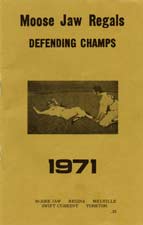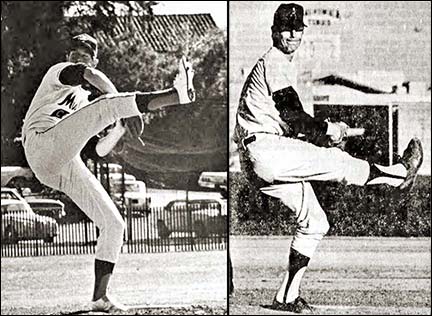
 It was quite a summer in the Southern League. The player selected as the SBL's most valuable was dumped by his initial team after going 1-4. Picked up by the Swift Current Indians in late June, Terry Buck (right) went on a tear winning six straight games and finishing second in the batting race with a .405 average. He was selected as the lefty starter on the All-Star team in addition to his MVP award.
It was quite a summer in the Southern League. The player selected as the SBL's most valuable was dumped by his initial team after going 1-4. Picked up by the Swift Current Indians in late June, Terry Buck (right) went on a tear winning six straight games and finishing second in the batting race with a .405 average. He was selected as the lefty starter on the All-Star team in addition to his MVP award.
 The Moose Jaw Regals, riding the strong arm of Fred Cardwell (left), ran away with the league pennant then defeated Swift Current in the playoff final to capture the championship for the second consecutive season. Cardwell, 5-2, 2.09 during the regular season, won five straight games in the playoffs. He pitched 32 consecutive scoreless innings at one point and finished the playoff run allowing just three runs in the five games.
The Moose Jaw Regals, riding the strong arm of Fred Cardwell (left), ran away with the league pennant then defeated Swift Current in the playoff final to capture the championship for the second consecutive season. Cardwell, 5-2, 2.09 during the regular season, won five straight games in the playoffs. He pitched 32 consecutive scoreless innings at one point and finished the playoff run allowing just three runs in the five games.
Sunday, June 13, 1971, the Melville Millionaires played a Southern League doubleheader against the Regals at Moose Jaw's Ross Wells Park. It was pretty ordinary in many ways, but years later the significance would be clear for two of the players involved that day.
 Catching for the Regals in the second game of the doubleheader was 17-year old Clark Gillies (right), who a year previous had signed a professional baseball contract with the Houston Astros, but had decided to spurn the life of rookie league baseball in the boondocks to return to Saskatchewan and pursue a career in hockey, a wise choice considering his ultimate attainment of four Stanley Cup rings as a member of the New York Islanders plus his election to the
Catching for the Regals in the second game of the doubleheader was 17-year old Clark Gillies (right), who a year previous had signed a professional baseball contract with the Houston Astros, but had decided to spurn the life of rookie league baseball in the boondocks to return to Saskatchewan and pursue a career in hockey, a wise choice considering his ultimate attainment of four Stanley Cup rings as a member of the New York Islanders plus his election to the  Hockey Hall of Fame in 2002. In the other dugout was Terry Puhl, a soon-to-be 15-year old standout with the midget Melville Elks, who had been called up to perform temporarily for the pitching-strapped Millionaires. Primarily a pitcher in those days, Puhl appeared in a relief role in both games, chalking up seven innings of mound work in total. He, too, was destined to sign a pro contract with the Astros in the fall of 1973, a move which culminated in a fifteen year career in the major leagues and induction into both the Saskatchewan and Canadian Baseball Halls of Fame.
Hockey Hall of Fame in 2002. In the other dugout was Terry Puhl, a soon-to-be 15-year old standout with the midget Melville Elks, who had been called up to perform temporarily for the pitching-strapped Millionaires. Primarily a pitcher in those days, Puhl appeared in a relief role in both games, chalking up seven innings of mound work in total. He, too, was destined to sign a pro contract with the Astros in the fall of 1973, a move which culminated in a fifteen year career in the major leagues and induction into both the Saskatchewan and Canadian Baseball Halls of Fame.
Prairie left-handers were making quite an impression in college ball in the United States. Les Lisowski of Winnipeg (below right) , recruited by the University of Arizona at Tucson, fired a no-hitter on March 22nd as the Wildcats blanked Northern Colorado 5-0. Lisowski, who had pitched just six innings before getting the start, struck out 16 and walked three in facing just 30 batters.
Southpaw Les Ohrn of Dapp, Alberta (below left) won a scholarship to California Polytechnic State University (Cal Poly, San Luis Obispo) and quickly moved right into the starting rotation as a freshman. On May 9, 1971, he fired a no-hitter against Cal Poly Pomona, winning 1-0 with a run in the top of the ninth. Ohrn walked five, but three of the base runners where thrown out by catcher Robin Bagget.With a 2.24 ERA, Ohrn still holds the second best ERA mark in Mustang history.


Semi-pro ball continued in Alberta with the Alberta Major League, a five-team circuit with two Edmonton teams (Tigers, Angels), two Calgary teams (Giants, Cubs) and the Red Deer Elks.
Edmonton Tigers captured the league pennant, topping the league by 2 1/5 games, but the fourth place Calgary Foothills Giants prevailed in the playoffs downing their city rivals, the Cubs, in the final series.
